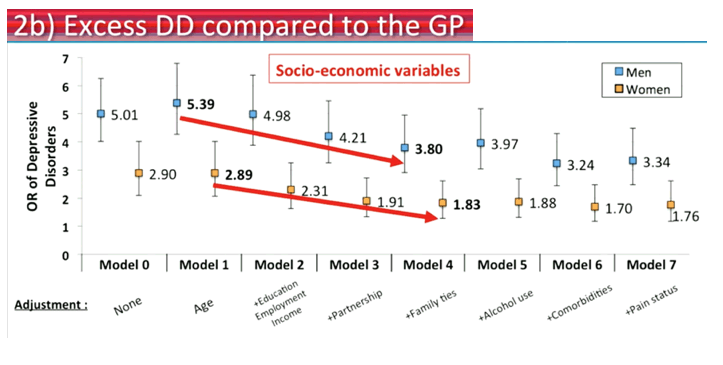 |
 |
 |
| |
Stigma Drives Higher Depression Rate in HIV+ Men and Women in France
|
| |
| |
18th European AIDS Conference, EACS 2021, October 27-30, 2021, London
Mark Mascolini
Compared with the general population, HIV-positive women in southwestern France had a 3-fold higher risk or depressive disorder and HIV-positive men had a 5-fold higher risk [1]. Stigma emerged as the only HIV-related factor linked to depression in women and men with HIV. HIV-positive women who did not feel stigma had the same chance of depression as women without HIV. But HIV-positive men who did not feel stigma still had a 2- to 3-fold higher chance of depression than men in the general population.
Previous research found that people with HIV run a 2 to 5 times higher chance of depressive disorder than people in the general population. Researchers from the University of Bordeaux and collaborators at other centers wondered if improvements in HIV care, including stronger and better-tolerated antiretrovirals, have affected rates of depressive disorder. In this comparison of a large HIV cohort in southwestern France (QuAliV study, 2018-2020/AQUIVIH-NA cohort) and a large national general-population group (EHIS-ESPS, 2014), they aimed to estimate prevalence of depressive disorder in people with HIV compared with the general population and to identify HIV-specific risk factors for depression.
AQUIVIH is an open, multicenter, prospective, hospital-based cohort of HIV-positive people at least 18 years old with epidemiologic, clinical, laboratory, and therapeutic data recorded since 1987. Between July 2018 and March 2020, cohort members at 6 of 16 centers completed questionnaires about socioeconomic variables, behavior, quality of life, and mood. The EHIS-ESPS survey, 2014 is a nationally representative group of 14,827 randomly selected health insurance beneficiaries at least 18 years old. The depression analysis focused on individuals who completed Patient Health Questionnaire-8 (PHQ-8), which measures current depression [2].
The HIV group included 683 men and 231 women with median ages of 56 and 54 and median times since HIV diagnosis of 21 and 23 years. More than 93% of both men and women had an undetectable viral load, and 78% had a CD4 count above 500. Almost one third of women (31.2%) were of foreign descent, compared with 7.5% of men. Depressive disorder prevalence was similar in men (20.8%, 95% confidence interval [CI] 17.8 to 23.8) and women (22.5%, 95% CI 17.1 to 27.9).
Separate logistic regression analyses in HIV-positive men and women found only one HIV-specific factor-stigma-that predicted depressive disorder in men (severe versus no stigma, adjusted odds ratio [aOR] 2.51, 95% CI 1.33 to 4.74; moderate versus no stigma, aOR 1.75, 95% CI 1.02 to 3.01) and women (severe versus no stigma, aOR 6.71, 95% CI 2.31 to 19.55, moderate versus no stigma, not significant). Factors that did not predict depressive disorder in these analyses included AIDS, time since HIV diagnosis, nadir and current CD4 count, third antiretroviral agent, and history of hepatitis C.
Depressive disorder prevalence was always higher in men and women with HIV than in general-population men and women regardless of age group (under 40, 40 to 50, 50 to 60, and over 60), although the difference between people with HIV and the general population diminished with age.
Unadjusted logistic regression determined that men with HIV had 5-fold higher odds of depressive disorder than men in the general population (OR 5.01, 95% CI 4.02 to 6.25), while women with HIV had almost 3-fold higher odds than general-population women (OR 2.90, 95% CI 2.10 to 4.02). In successive models adjusted for age; education, employment, and income; partnership; family ties; alcohol use; comorbidities; and pain status, odds of depressive disorder remained higher in men and women with HIV than in their general-population counterparts.
When the researchers figured odds of depressive disorder in these 8 models according to stigma severity, they found that higher odds of depressive disorder in men with HIV than without HIV diminished depending on whether men with HIV felt severe, moderate, or no stigma. But even in HIV-positive men who felt no stigma, odds of depressive disorder remained 2.2- to 3.7-fold higher with HIV than without HIV (depending on the model). In contrast, higher odds of depressive disorder in women with HIV than without HIV diminished in women who felt moderate versus severe stigma and disappeared in HIV-positive women who felt no stigma. In other words, HIV-positive women who felt no HIV stigma did not have higher odds of depressive disorder than women in the general population.
"In spite of improvements in HIV care," the researchers proposed, "reducing the burden of HIV-stigma in both women and men may help to alleviate excess depressive disorder, especially among younger people living with HIV."
References
1. Hémar V, Hessamfar M, Neau D, et al. Factors associated with excess depressive disorder in women and men living with HIV in south-western France compared to the general French population (QuAliV/AQUIVIH-NA Cohort). 18th European AIDS Conference, EACS 2021, October 27-30, 2021, London. Abstract BPD3/5.
2. Kroenke K, Strine TW, Spitzer RL, et al. The PHQ-8 as a measure of current depression in the general population. J Affect Disord. 2009;114:163-73. doi: 10.1016/j.jad.2008.06.026.

|
| |
|
 |
 |
|
|